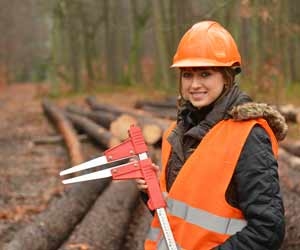Forestry Aids and Technician Jobs
If you’ve been considering some type of seasonal outdoor job for the summer or semester break, a forestry aid or technician job might be just what you are looking for. The US Forest Service offers a multitude of summer jobs and this category of aids and technicians holds the largest number of employees. In fact, technicians and aids all across the nation perform the majority of the work done during the summer season – the busiest time of year for the Forest Service.

Imagine not just exploring and experiencing the great outdoors in ways others can only dream about, but working all across America in places like Oregon’s Deschutes, Montana’s Lolo or Missouri’s Mark Twain National Forests.
Technician and aid jobs truly are for those who love the backcountry of the forest and want to live their lives surrounded and engulfed by nature. They will spend days on end with no human contact, carrying everything they need to survive on their back, facing nature at every turn and all that it has to offer. If you want to see parts of the country that few people ever have – and get paid to do so – these types of jobs may be the start of a career path that will carry you through your life. The tasks vary, and you may find yourself assessing water sources, land, animal, plants, trees and other natural resources found in the forest.
FACT! The process of clear cutting is considered a sound practice by many recognized forest scientists. Because it mimics wildfires that occur in nature, it is an ecologically sound technique that contributes to the reforesting of many softwood species. These types of trees can’t survive in the shade, and clear cutting provides them with the sunlight that they need.
Job Descriptions
Let’s explore the various types of forestry aid and technician positions that are available for seasonal and temporary employees. Remember, most of these jobs require that you live in the backcountry with little or no contact with other human beings.
- Forestry Aids and Forestry Technicians perform a wide variety of duties. They keep careful track of rainfall data, measure the heights and diameters of trees, maintain the campgrounds, thin out the young timber stands to enhance productivity, fight fires, and man the forest-fire lookout towers.
- Hydrologic Aids and Technicians work alongside the professional hydrologists and provide them with the support they need. They chart and report preparation efforts, as well as collect, compute, and process the hydrologic data.
- Physical Science Aids and Technicians assist physical scientists by calibrating and operating measurement instruments, mixing solutions and performing chemical analyses, compiling and processing scientific data, and assembling and operating the test equipment.
- Biological Aids and Technicians provide technical support and other assistance to biologists. They work in agricultural and biological laboratories as well as in greenhouses, fish hatcheries, wildlife refuges and growth houses.
- Surveying Aids and Technicians work alongside surveying crews. They are involved in road construction, chaining and staking new routes, and clearing power and communication lines. These employees also sometimes serve as firefighters during wildfires or periods of high fire danger.
- Range Aids and Technicians help manage, conserve, develop, and protect rangeland in the public domain to ensure continuing production of forage for livestock and wild game.
FACT! Because of the efforts of the U.S. Forest Service and similar agencies and organizations, we have more trees today than we had in 1970, or even 70 years ago. For example, in the middle of the last century, Vermont, Massachusetts and Connecticut were about 35 percent forested, but today they are at 59 percent.
All of the technicians and aids who work in our forests provide an invaluable service to our country, the environment and of course, the Forest Service. While some jobs only require a willingness to work and make a difference, others require experience, skill or educational requirements, so be sure to check the job listings carefully. Either way, there’s no better way to truly see, feel, taste and experience the backcountry like when you work and live in it. In most states pay starts at around $12 an hour, but it climbs to as much $25 per hour, depending on the job and the location.
Quick Summary:
- Forestry jobs are truly for those who love the forest and the backcountry.
- Most of the technician and aid jobs are seasonal during the summer months and should be applied for as soon as possible (usually January to April).
- This is one of the largest categories of jobs in the Forest Service, and includes fulltime and seasonal workers.
- Technician and aid jobs all need various levels of experience and knowledge. Some need manual labor skills while others require some scientific knowledge.
- Aids and technicians can work side-by-side with others, or spend days on end with no contact with other people.


 Teach English in Asia
Teach English in Asia  Cruise Ship Jobs
Cruise Ship Jobs  Alaska Fishing Industry Jobs
Alaska Fishing Industry Jobs  Sharing Economy / Gig Economy
Sharing Economy / Gig Economy